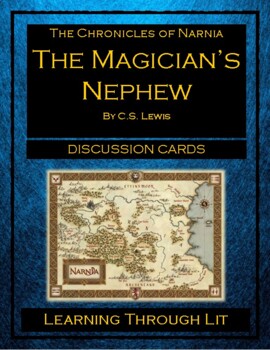Chronicles of Narnia THE MAGICIAN'S NEPHEW Discussion Cards (Answers Included)
- PDF
- Easel Activity
Description
This resource addresses this novel as an allegory, as C.S. Lewis intended. Students will be asked to compare/contrast events in the book to events in the Bible.
Rationale for using Discussion Cards:
- This strategy is powerful in giving students opportunities to work together in mixed-ability, student-led groups. Lower level students benefit from listening to higher level students respond to questions. Higher level students are challenged to express their thinking in a way that helps lower level students comprehend the material.
- Discussions are guided by students’ responses to what they have read. This approach provides a way for students to engage in critical thinking and reflection as they read, discuss, and respond to books. Collaboration is at the heart of this approach. Students reshape and add to their understanding as they construct meaning with other readers.
- The Discussion Cards have questions from each chapter prompting students to cite evidence from the text and take their thinking to a deeper level.
Perfect for:
- Literature Circles
- Book Clubs
- Guided Reading
- Comprehension Check
- Speaking and Listening Skills
- Formative Assessment
- Distance Learning
- Differentiation
Quick Set Up!
- Print, laminate pages, cut out and staple at the top or insert ring binder Perfect size to fit inside library pocket inside front cover of books!
- Easel activity to complete on a device - I included a response page after each page of questions in the event you would like for students to complete work to turn in. Answer pages are also included but you may delete those or advise students how and when to use them.
I successfully used my discussion cards for Component 3 of National Board Certification in Literacy: Reading – Language Arts / Early and Middle Childhood. :)
What I love most about using the cards with my students: I love so many things about them but I especially love how they get all serious about their discussions when they have the little clipboard questions in their hands. It makes them feel official, like the little scholars they are.
I also have this resource available in a pencil/paper format.
What users are saying about my Discussion Cards:
Noel H.
My highest level book club used this resource as discussion prompts. They enjoyed the step up to student led and facilitated literature circle.
Ashley O.
I used this for my higher reading group to work independently. They were able to read a chapter and answer the questions as a group.
Kaitlin W.
Helpful resource to guide thoughtful discussions.
Misty L.
Great resource for extending discussions during our class read aloud.
Kathryn L.
Print and go activity to extend our class read aloud into centers. Very easy and effective.






